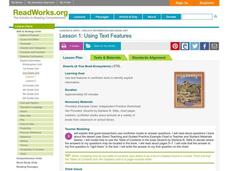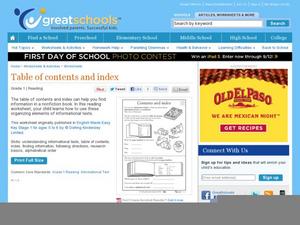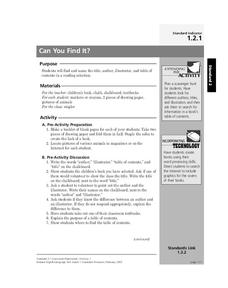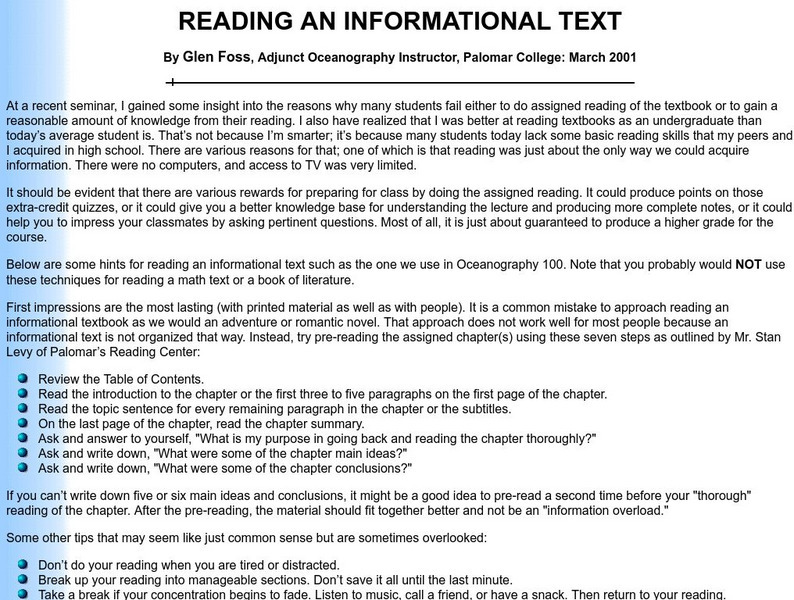Curated OER
Introduce: Comprehension Monitoring using About Trees
As scholars begin reading more difficult text, they need to acquire an arsenal of comprehension strategies. Here are few helpful ones to guide new readers through the informational text About Trees, which is linked here for printing....
Curated OER
Using Text Features
Investigate a "table of contents" with your students! They read the table of contents in Deserts by Darlene R. Stille and predict where the answers to specific questions might be found. Learners complete a worksheet in which they find...
Teacherfiles
Portfolio Contents
Learners can create a portfolio in any class and use this handy table of contents to organize their work effectively. Individuals are asked to include their best work alongside work that demonstrates areas for progress. The table of...
Curated OER
"Me" Resource
Learners elucidate themselves by writing up to six entries in different formats. Some formatting choices include a dictionary, encyclopedia, or atlas entry, a magazine article, a newspaper article, and a table of contents. Some...
Curated OER
Nonfiction Books: Table of Contents and Index
How do you find what you're looking for when reading a nonfiction book? Even first graders can learn how to use a table of contents and an index. They use the provided images of each to locate information and answer nine questions.
Curated OER
Contents and Index
It's important for your readers to understand features of informational text such as index and table of contents, so give them this visual activity to get started. They read a brief explanation of informational text, then look at an...
Curated OER
Can You Find It?
Plan a Parts of a Book scavenger hunt. Begin by giving your young adventurers a book, and asking them to find the title, author, illustrator, and table of contents. After a discussion of the purpose of each of these items, class members...
Curated OER
Review Parts of a Book
Begin the year with a review of the parts of a book. Exercises in the unit plan ask emergent readers to identify the information on the cover of a book and on the title page, to explain the purpose of a table of contents, and to describe...
Curated OER
Contents Page 1 (Table of Contents)
After inspecting the illustrated sample of a Table of Contents provided on a one-page worksheet, primary readers write their responses to five questions based on the model.
Curated OER
School-Home Links
Engage parents in their child’s learning process with a School-Home Links worksheet. The one-page resource offers a definition and an example of a book with chapters. With the guidance of their parent or learning partner, the child...
Curated OER
Identifying Features of Nonfiction Text
Learners explore nonfiction text. They identify the cover, title page, and table of contents of a nonfiction book. Pupils work in groups to create a chapter for a nonfiction class book about heroes.
Curated OER
Using a Table of Contents
While simple, this resource would be a great way to introduce your class to the use of the Table of Contents. It provides a step-by-step explanation describing how to find information. A teacher could supplement this presentation with...
Curated OER
Table of Contents
In this table of contents worksheet, students read information about the table of contents and use a practice example to answer questions. Students answer four questions using the table of contents.
Curated OER
Glossary, Index, and Table of Contents
Fourth graders use two separate sources to learn about index, glossary, and table of contents usage. In this library lesson plan, 4th graders use two books, Learning About Weather with Graphic Organizers, and The World Almanac for Kids,...
Curated OER
Researching Lesson 4
Students explore a "table of contents." In this book researching lesson, students identify common elements of a "table of "contents" and complete a worksheet with questions about this topic.
Curated OER
Library Lesson Plan: Table of Contents
Third graders create a table of contents. In this library skills lesson, 3rd graders read Welcome to the White House and use the provided worksheet to create a table of contents for the book.
Curated OER
Using the Table of Contents
Students critique a table of contents to find information in a book. Students locate their text books and then locate the table of contents in each one. Students research purposes for the table of contents in books.
Curated OER
Animal Report (Lesson 5 - Location and Access - Grade 4)
Fourth graders practice finding answers to various questions using the Table of Contents and Index of a sample resource book. They complete a practice worksheet.
Curated OER
School-Home Links: Table of Contents
In this book section activity, students review the purpose of the table of contents in a book. Students then answer several questions using a table of contents. Parents or guardians must sign the activity.
Curated OER
Creating a How To Book
Third graders investigate "How To" books by watching a "How To" video and looking at books in the media center. They make a class "How To" book with a title page, table of contents, individual student pages, and graphics which they make...
Curated OER
Reading Predictions
Second graders read and predict content and purpose for table of contents, index, headings, captions, illustrations, and major words from their science or social studies textbooks. They use books' elements to summarize what they can find...
PBS
Pbs Learning Media: Molly of Denali: Fish Camp Game
Use this Molly of Denali digital game to extend and expand students' use of informational text as well as their knowledge of Alaska Native culture.
Quia
Quia: Parts of a Book
This website provides chart lists and defines the parts books all readers should know, such as the title, author, table of contents, and glossary. Click on "Back to activity," to be taken to four games, which will help students learn and...
Palomar Community College District
Palomar College: Reading an Informational Text
Glenn Foss, an instructor at Palomar College, discusses some possible reasons why students have problems reading and recalling textbook material. Provides an outline for seven steps of effectively reading assigned material.

























